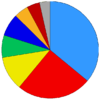- Joint Research Centre
-

European Union 
This article is part of the series:
Politics and government of
the European UnionPolicies and issuesThe Joint Research Centre (JRC), located in Brussels, Belgium, is a Directorate-General of the European Commission.[1] Its current Commissioner is Máire Geoghegan-Quinn,[1] and the Director General is Dominique Ristori.[2] The JRC provides independent scientific and technical advice to the European Commission and Member States of the European Union (EU) in support of EU policies.[3] The Directorate General, the Directorate for Programmes and stakeholders relations and the Directorate for Resource management are located in Ispra, Italy, and Brussels, Belgium. The seven scientific institutes of the Joint Research Centre are located at five different sites in Europe: Geel (BE), Ispra (IT), Karlsruhe (DE), Petten (NL) and Seville (ES).[1]
Contents
Mission
The EU inherited the JRC from EURATOM. Originally focussed on nuclear research, the mission has been extended to fields like health and environment. Today, the official mission statement reads:
"The mission of the JRC is to provide customer-driven scientific and technical support for the conception, development, implementation and monitoring of EU policies. As a service of the European Commission, the JRC functions as a reference centre of science and technology for the Union. Close to the policy-making process, it serves the common interest of the Member States, while being independent of special interests, whether private or national."[3]
Structure
The organisation structure is currently based on the following specialised Institutes.[1]
- Brussels, Belgium
- The Directorate General (DG)
- The Programmes and stakeholders relations Directorate (PSR)
- The Directorate for Resource management (DRM)
- Geel, Belgium
- Karlsruhe, Germany
- The Institute for Transuranium Elements (ITU)
- Ispra, Italy
- Petten, Netherlands
- The Institute for Energy (IE)
- Sevilla, Spain
Critique
The EURATOM research institutes have been criticized since the 1970s for overmanagement and scientific unproductivity. For instance, a report to the European Parliament in the mid-1980s "condemned the centres for their top-heavy management. At Ispra, Italy, 700 of the 1600 staff are listed as researchers. But the report claims that most of them are full-time administrators. The actual scientific life of the institute rests on 30-40 people."[4]
See also
- Directorate-General
- Directorate-General for Research
- Directorate-General for Information Society and Media (European Commission)
- ERAWATCH
- European Research Area (ERA)
- European Research Council (ERC)
- European Institute of Technology (EIT)
- European Research Advisory Board (EURAB)
- European School
- Framework Programmes for Research and Technological Development
- Joint Technology Initiative
- Lisbon Strategy
- Seventh Framework Programme
- Sixth Framework Programme
References
- ^ a b c d http://ec.europa.eu/dgs/jrc/index.cfm?id=1440
- ^ http://ec.europa.eu/dgs/jrc/downloads/jrc_cv_dominique_ristori_en.pdf
- ^ a b http://ec.europa.eu/dgs/jrc/index.cfm?id=1370
- ^ New Scientist, 11 December 1986, p. 17.
External links
Administration of the European Commission 
Civil Service 
Policy DGs Agriculture · Climate Action · Competition · Economic and Financial Affairs · Education and Culture · Employment, Social Affairs and Equal Opportunities · Enterprise and Industry · Environment · Fisheries and Maritime Affairs · Health and Consumers · Home Affairs · Information Society and Media · Internal Market and Services · Joint Research Centre · Justice · Regional Policy · Research · Taxation and Customs Union · Mobility and Transport · EnergyExternal DGs Foreign Policy Instruments Service · Enlargement · Trade · EuropeAid Development and Cooperation · Humanitarian Aid OfficeGeneral Services Internal Services Buildings Categories:- European Union and science and technology
- Science and technology in Europe
- Directorates-General in the European Commission
- Brussels, Belgium
Wikimedia Foundation. 2010.






